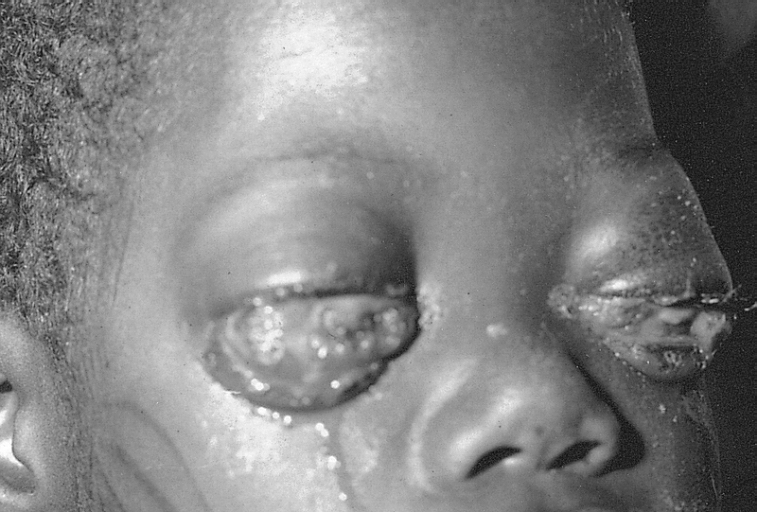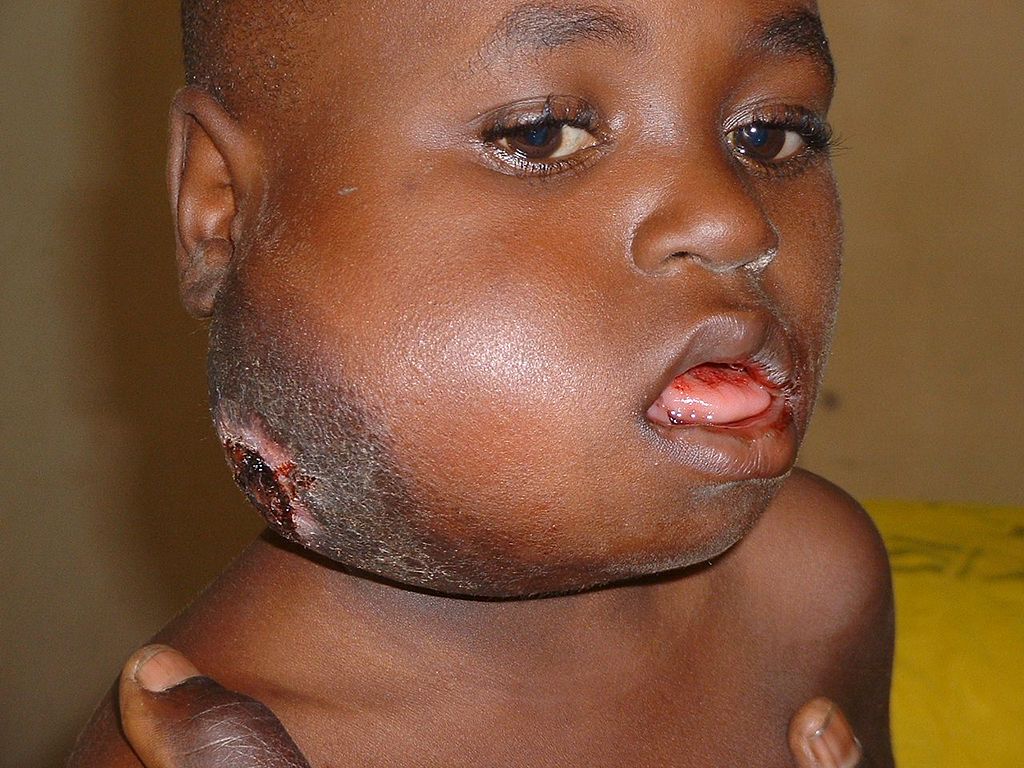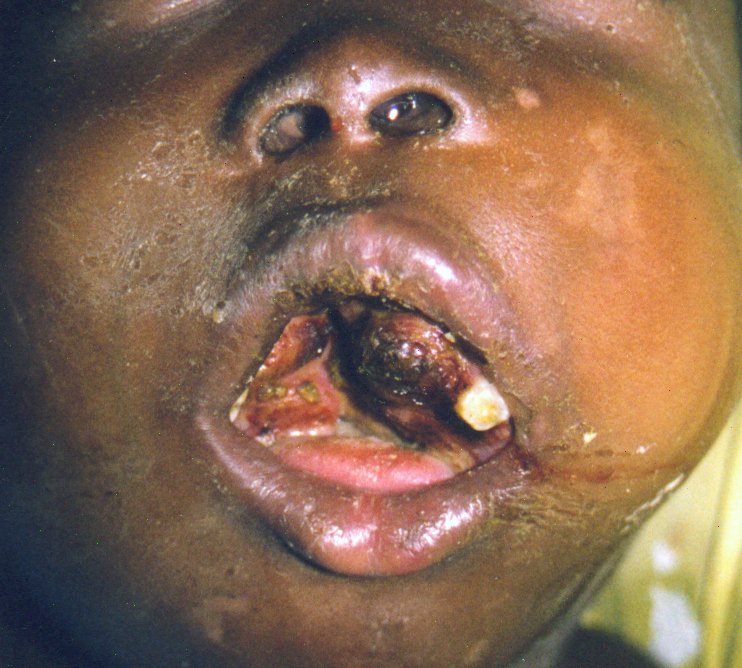Burkitt's lymphoma pathophysiology
|
Burkitt's lymphoma Microchapters |
|
Diagnosis |
|---|
|
Treatment |
|
Case Studies |
|
Burkitt's lymphoma pathophysiology On the Web |
|
American Roentgen Ray Society Images of Burkitt's lymphoma pathophysiology |
|
Risk calculators and risk factors for Burkitt's lymphoma pathophysiology |
Editor-In-Chief: C. Michael Gibson, M.S., M.D. [1];Shivali Marketkar, M.B.B.S. [2], Associate Editor(s)-in-Chief: Sowminya Arikapudi, M.B,B.S. [3]
Overview
Gene involved in the pathogenesis of Burkitt's lymphoma includes c-myc. On gross pathology, ulceration and discharge are characteristic findings of Burkitt's lymphoma. On microscopic histopathological analysis, "starry sky" appearance is characteristic finding of Burkitt's lymphoma.
Genetics
All types of Burkitt's lymphoma are characterized by dis regulation of the c-myc gene by one of three chromosomal translocations.[1] This gene is found at 8q24.
- The most common variant is t(8;14)(q24;q32), which accounts for approximately 85%[1] of cases. This involves c-myc. A variant of this, a three-way translocation, t(8;14;18), has also been identified.[2]
- A rare variant is at t(2;8)(p12;q24).[3] This involves c-myc.
- Another rare variant is t(8;22)(q24;q11).[3] This involves immunoglobulin lambda locus IGL@ and c-myc.
Combined, the two less-common translocations, t(2;8)(p12;q24) and t(8;22)(q24;q11), account for the remaining 15% of cases not due to the t(8;14)(q24;q32) translocation.[1]
Gene targets
Unique genetic alterations promote cell survival in Burkitt's lymphoma, distinct from other types of lymphoma.[4] These TCF3 and ID3 gene mutations in Burkitt's correspond to a cell survival pathway that may be found to be amenable to targeted therapy.[5]
MicroRNA expression
In 2014, it was described that short non-coding RNAs named microRNAs (miRNAs) have important functions in lymphoma biology. In malignant B cells miRNAs participate in pathways fundamental to B cell development like B cell receptor (BCR) signalling, B cell migration/adhesion, cell-cell interactions in immune niches, and the production and class-switching of immunoglobulins.[6] MiRNAs influence B cell maturation, generation of pre-, marginal zone, follicular, B1, plasma and memory B cells.[6]
Immunohistochemistry
The tumor cells in Burkitt lymphoma generally strongly express markers of B cell differentiation (CD20, CD22, CD19), CD10, and BCL6. The tumor cells are generally negative for BCL2 and TdT. The high mitotic activity of Burkitt lymphoma is confirmed by nearly 100% of the cells staining positive for Ki67.[7]
Malignant B cell characteristics
Malignant B cells have identical DNA recombinations of the V(D)J region of the immunoglobin genes. This means that no increase in specificity of antibody molecules is occurring in the malignant cells. These malignant cells are thus clonal populations and can be assayed for by using DNA probes specific for the regions where recombination is expected. Normal DNA will be characterized by two high concentration of identical germ line DNA V (D) J regions and endless, likely undetectable, non-germline Ig V(D)J DNA. Lymphoma cells have an additional high concentration of V(D)J DNA that is unlike the germ line, indicating clonal populations of B Cells that are not undifferentiated B cells (germ line DNA cells). Assays typically use the process of electrophoresis and southern blot analysis to determine the existence of these characteristics.
Gross Pathology
-
Burkitt lymphoma: bilateral eye involvement
-
Seven-year-old Nigerian boy with a several-month history of jaw swelling which had been treated with antibiotics: The tumor was ulcerated and draining
-
Picture of a mouth of a patient with Burkitt lymphoma showing disruption of teeth and partial obstruction of airway
Microscopic Pathology
The tumor consists of sheets of a monotonous (i.e. similar in size and morphology) population of medium size lymphoid cells with high proliferative activity and apoptotic activity. The tumor cells are mostly medium in size (i.e. tumor nuclei size similar to that of histiocytes or endothelial cells). Tumor cells possess small amount of basophilic cytoplasm. The cellular outline usually appears squared off.
Features:
- "Starry-sky pattern":
- The stars in the pattern are: tingible-body macrophages
- Tingible-body macrophages = macrophages containing apoptotic tumour cells
- The tumour cells are the sky
- The stars in the pattern are: tingible-body macrophages
- Tumour cells:[8]
- Medium-sized (~1.5-2x the size of a RBC) with uniform size ("monotonous") -- key feature
- Round nucleus
- Small nucleoli
- Relatively abundant cytoplasm
- Brisk mitotic rate

Video
{{#ev:youtube|CwsQ-wIbbK8}}
References
- ↑ 1.0 1.1 1.2 Hoffman, Ronald (2009). Hematology : basic principles and practice (PDF) (5th ed. ed.). Philadelphia, PA: Churchill Livingstone/Elsevier. pp. 1304–1305. ISBN 978-0-443-06715-0.
- ↑ Liu D, Shimonov J, Primanneni S, Lai Y, Ahmed T, Seiter K (2007). "t(8;14;18): a 3-way chromosome translocation in two patients with Burkitt's lymphoma/leukemia". Mol. Cancer. 6: 35. doi:10.1186/1476-4598-6-35. PMC 1904237. PMID 17547754.
- ↑ 3.0 3.1 Smardova J, Grochova D, Fabian P; et al. (2008). "An unusual p53 mutation detected in Burkitt's lymphoma: 30 bp duplication". Oncol. Rep. 20 (4): 773–8. PMID 18813817. Unknown parameter
|month=ignored (help) - ↑ "NIH study shows Burkitt lymphoma is molecularly distinct from other lymphomas". National Cancer Institute.
- ↑ Staudt L, et al. Burkitt Lymphoma Pathogenesis and Therapeutic Targets from Structural and Functional Genomics. Nature. August 12, 2012 doi:10.1038/nature11378
- ↑ 6.0 6.1 Musilova, K; Mraz, M (2014). "MicroRNAs in B cell lymphomas: How a complex biology gets more complex". Leukemia. doi:10.1038/leu.2014.351. PMID 25541152.
- ↑ . ISBN 978-92-832-2431-0. Missing or empty
|title=(help) - ↑ Bellan C, Lazzi S, De Falco G, Nyongo A, Giordano A, Leoncini L (2003). "Burkitt's lymphoma: new insights into molecular pathogenesis". J. Clin. Pathol. 56 (3): 188–92. PMC 1769902. PMID 12610094. Unknown parameter
|month=ignored (help)


